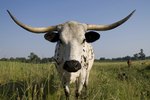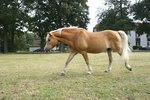
All donkeys belong to a single species, Equus asinus. Regardless of their size, coloration or what they’re called, all donkeys are donkeys -- there are no recognized subspecies. Within donkey registration societies and associations, the animals are grouped according to height and type. Donkey is the correct term for any domesticated ass. The name burro is borrowed from Spanish, and typically applied to feral donkey populations that roam Mexico and the southwestern United States.
General Physical Features
As a species of the Equus, or horse family, donkeys physically resemble horses. They tend to have shaggier coats than horses, and are distinguished by their large heads and ears. Their fur most often is gray, but also can be any shade of black, brown or white, or any combination of those colors. Donkeys also are characterized by a mane that stands up straight rather than flowing down over their neck. They have stockier builds than most horses and long have been valued as beasts of burden.
American Classification
The American Donkey and Mule Society (ADMS) classifies donkeys according to size for the purposes of registering the animal. Most donkeys are “standard donkeys” with a height of between 36 and 48 inches at the shoulder. Animals referred to as burros usually are standard-sized donkeys. In contrast, miniature donkeys stand less than 36 inches in height at the shoulder. The ADMS also has a registration class for mammoth donkeys, which are taller than 54 inches at the shoulder. Mammoth donkeys are rare compared to other size classifications.
Miniature Mediterranean Donkeys
The Miniature Mediterranean Donkey is a recognized donkey breed governed in the United States by the National Miniature Donkey Association. These compact, well-proportioned donkeys originated in Northern Africa, and the islands of Sardinia and Sicily. Those disparate native populations merged into one breed of animal distinct from other donkeys. All miniature donkeys are less than 36 inches tall at the shoulder, and weigh less than 400 pounds.
Feral Burros
Since most burros are standard donkeys, they are larger than miniature donkeys. The name burro is used properly for feral donkeys, populations descended from animals that originally were domestic but grew wild over the course of generations. A domestic, farm-raised donkey is not referred to as a burro. Feral burros run wild across much of the western United States. Burros are legally protected from slaughter, and are governed by the Bureau of Land Management.
References
Photo Credits
-
Jupiterimages/Photos.com/Getty Images
Writer Bio
Jennifer Mueller began writing and editing professionally in 1995, when she became sports editor of her university's newspaper while also writing a bi-monthly general interest column for an independent tourist publication. Mueller holds a Bachelor of Arts in political science from the University of North Carolina at Asheville and a Juris Doctor from Indiana University Maurer School of Law.



